
WilbertEDU® December Recap
On November 30, Daniell R. Wilk, Port Mortuary Branch Chief at Air Force Mortuary Affairs Operations, Dover Air Force Base, Delaware, presented "Air Force Mortuary Affairs Operations" to the delight of over 700 WilbertEDU attendees. The live broadcast and walk-through of the operations center at Dover was a unique opportunity for attendees to get a behind-the-scenes look at Mortuary Operations at Dover Air Force Base, including triage, embalming, overflow, dress and restoration, and departures.
Danielle began her presentation at the atrium, where a memorial wall lists all US conflicts. From the atrium, Danielle walked through the facility to the embalming suite while describing to the audience about how deceased service members are processed through Dover:
Not all deceased service members go through Dover for mortuary care; some are cared for by contract funeral homes across the country. Most service members sent to Dover are at the direction of the Armed Forces Medical Examiner for autopsy and investigation. Service members arrive at Dover on a "believed to be" status; identities are confirmed using DNA and dental records. The average age for a deceased service member arriving at Dover is 25. Once identity is scientifically verified, the family is notified. Not all service members are processed through Dover. Some families choose to have a local funeral home care for their loved ones. In those cases, Dover arranges transportation of the service member.
Next, Danielle took attendees into the embalming suite, which has ten embalming stations, nine used for embalming and one used for viscera. At Dover, each embalmer has their own embalming station with two or three embalming machines because most remains are autopsied. After embalming is complete, measurements are taken and provided to the Branch of Service responsible for preparing the uniform according to the service members' awards and decorations. In unison, a liaison coordinates with the family to receive their loved one.
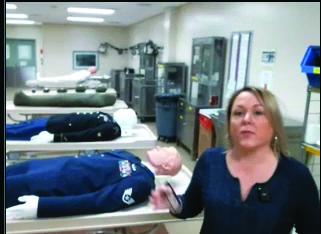
Danielle Wilk introduces the audience to Dress & Restoration where she will begin her demonstration on the four levels of viewability using mannequins.
Moving on, Danielle proceeded to the dress and restoration suite, where service members are prepared for viewing. Mannequins were used to demonstrate the four levels of viewability recommended by the Department of Defense (DOD).
Level 4 Viewable Remains typically have little or no trauma. View ID is when the remains are prepared for identification. These remains may not be pristine but can be restored with cosmetics or other restorative techniques.
Level 3 Head Wrap is utilized when the service member has sustained facial or head injuries that prevent "life-like" viewing. The remainder of the body is in dress uniform, which allows the family to have an open casket.
Level 2 Full Body Wrap is used when remains have been severely decomposed or sustained other significant trauma such that they cannot be viewed in a "life-like" condition. The remains are thoroughly embalmed, and as the name implies, the body is completely wrapped in accordance with DOD standards. This process can take two to four hours to complete. Once completed, the wrapped body is placed in the casket, and the dress uniform with awards and decorations is placed on top of the remains, which allows the family to have an open casket for non-viewable remains.
Level 1 Subsequent Portions applies when there an incident where the remains are not intact and subsequent portions are collected from the incident site before the site is closed. When that happens, subsequent portions are processed through Dover in the manner described earlier and, in the standards, set by the DOD. Subsequent portions are treated with respect and in the same dignified manner as other remains processed through Dover.
Next, Danielle demonstrated the head wrap using a mannequin and taking the audience step-by-step through the process while describing in detail the standards set by the DOD.
In the final five minutes of her presentation, Danielle shared the combination of embalming products used for embalming remains of service members. She then took questions from the audience, of which there were many. In the follow-up survey, the attendee expressed their desire to have Danielle back on the WilbertEDU stage. We are working with Danielle to see if we can make that happen in 2024!
On December 14, Wendy Wiener and Lauren Pettine returned to the WilbertEDU stage to provide an update on changes to laws across the country after the fall of Roe in 2022. "Handling Fetal Remains in the Wake of the Dobbs Decisions, Part II" is a follow-up to their March 16, 2023, WilbertEDU presentation.
Defining Fetal Remains
The laws governing the disposition of fetal remains are determined by each state which begins with a definition of gestational milestones between fetal remains and stillbirth/human remains. Four categories define fetal remains by state and vary across the country: 1) 20 weeks; 2) 20 week and/or 350 grams; 3) irrespective of gestational age, and 4) other.
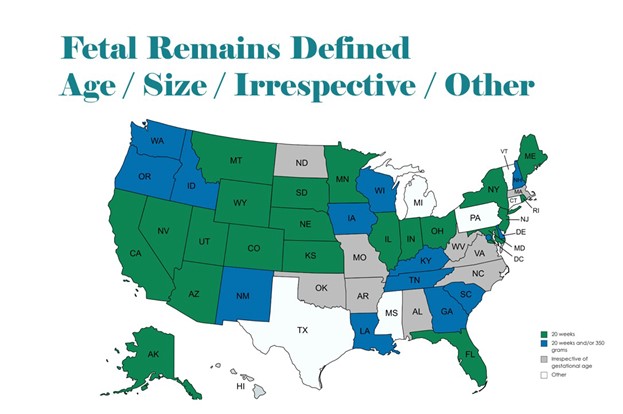
Figure 1 Effective 12-14-2023
Miscarriage v. Abortion
What produced the fetal remains – abortion or miscarriage - is a determining factor in how fetal remains are handled by death care professionals. States are not unified in how they treat fetal remains under these two methods. In more than half the states, the disposition of fetal remains is the same regardless of how those remains are produced. The remaining states provide different forms of disposition depending on how the fetal remains were produced.
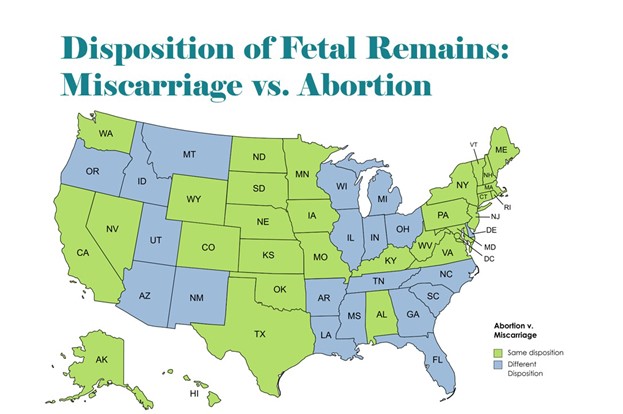
Figure 2 Effective 12-14-2023
State laws mandate the disposition of fetal remains and vary widely across the US as shown in the map below.
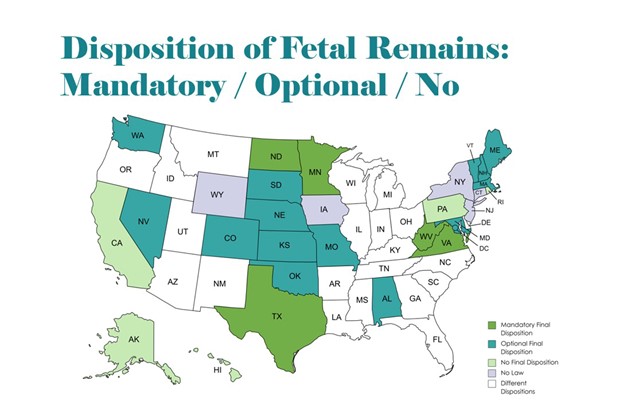
Figure 3 Effective 12-14-2023
State law also governs who can authorize the disposition of fetal remains. This also varies widely across the US as indicated in the map below.
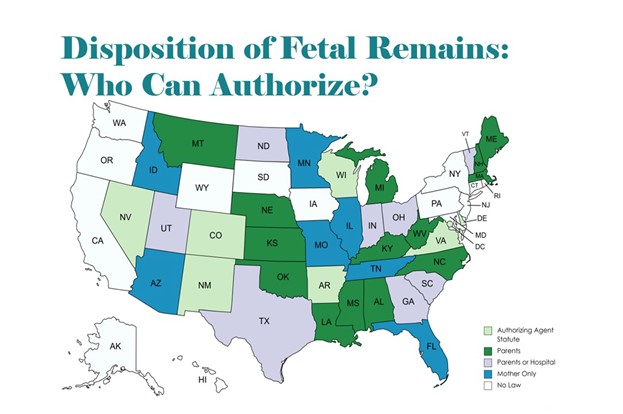
Figure 4 Effective 12-14-2023
Guidance for Death Care Providers
To determine how fetal remains are handled in your state, death care providers must know 1) laws defining fetal remains based on gestational age, 2) laws defining final disposition of fetal remains, and 3) laws pertaining to the authorizing agent.
Legislative Update
A proposed federal statue (SB 1102, Dignity for Aborted Children Act) would require final disposition of all fetal remains from abortion. This law has been filed before, however, there was not enough legislative consensus to move it forward. It is unlikely to pass but worth keeping an eye on.
On November 7, voters in Ohio amended the state constitution to include a constitutional right to abortion securing the right to abortion for anyone who wants to exercise that right. This is likely to impact disposition of fetal remains laws in Ohio.
Arizona has a mandate that the state adopt rules regarding the treatment of fetal remains resulting from an abortion but to date, Arizona has not begun the process of promulgating rules dictating the disposition of fetal remains.
USSC – Indiana
Box v. Planned Parenthood and Jane Doe v. AG of Indiana challenged Indiana law regarding mandatory final disposition of fetal remains. The Supreme Court denied the request to hear, upholding the Indiana law.
Fifth Circuit – Texas
Texas is appealing an injunction of Texas law requiring final disposition of fetal remains from abortions providers in Whole Women’s Health v. Phillips.
These are just a few of the cases making their way through the courts and we should expect many more of these types of cases in the future.
Next, Lauren shared that authorizing agent, cremation and required forms are some areas where death care providers handling fetal remains have the most concerns, questions, or confusion. She then discussed four case studies and their outcomes.
In summary, death care providers handling fetal remains are advised to:
-
Know your state laws!
-
Contact the appropriate authorizing agent before taking custody of fetal remains.
-
Complete authorization forms prior to taking fetal remains into your care.
-
Complete the final disposition pursuant to executed authorization.
And finally, a word of caution to death care providers handling fetal remains:
If you take possession of fetal remains prior to arrangements with the appropriate authorizing agent, you may not be able to dispose of the fetal remains without a court order.
Remember, WilbertEDU webinars are available to Licensees via the WilbertEDU Resources page at Wilbert.com/Wilbert-resources. A login is required.